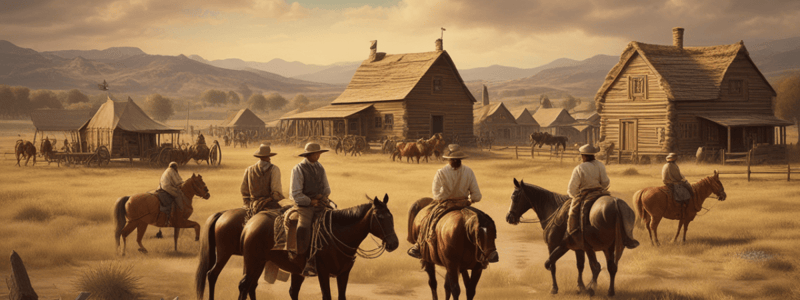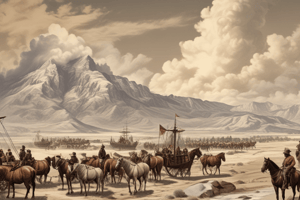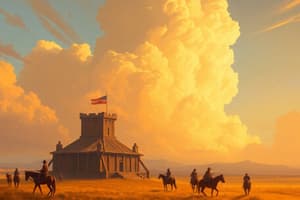Podcast
Questions and Answers
What was California a part of before the war?
What was California a part of before the war?
- The Mississippi Valley
- Oregon
- The United States
- Mexico (correct)
What made the area of Oregon attractive to settlers?
What made the area of Oregon attractive to settlers?
- Dramatized stories of Native American attacks
- The sparse settlement in the Sacramento Valley
- The missionary settlements
- The fertile farmland (correct)
What was more frequent and formidable than attacks from Native Americans during the journey?
What was more frequent and formidable than attacks from Native Americans during the journey?
- The fertile farmland
- Native American attacks
- The slow progress and disease (correct)
- The missionary settlements
What percentage of Americans living west of the Rockies in 1848 were in Oregon?
What percentage of Americans living west of the Rockies in 1848 were in Oregon?
How many Americans were living west of the Rockies in 1848?
How many Americans were living west of the Rockies in 1848?
What was the main purpose of the Tariff of 1816?
What was the main purpose of the Tariff of 1816?
What was the Missouri Compromise primarily concerned with?
What was the Missouri Compromise primarily concerned with?
Which region generally benefited from the Tariff of 1816?
Which region generally benefited from the Tariff of 1816?
What was the significance of the 36°30' parallel in the Missouri Compromise?
What was the significance of the 36°30' parallel in the Missouri Compromise?
What was a consequence of the divisions caused by the Tariff of 1816 and the Missouri Compromise?
What was a consequence of the divisions caused by the Tariff of 1816 and the Missouri Compromise?
Flashcards are hidden until you start studying
Study Notes
California and Oregon Settlement
- California was previously part of Mexico before the war, and it took at least three arduous months to travel from the nearest American settlements.
- The Sacramento Valley had some sparse settlement, with occasional visits from missionaries.
- Oregon's fertile farmland attracted more settlers than California, similar to the black dirt lands of the Mississippi Valley.
Challenges of the Journey
- The journey was slow and arduous due to disease, human and oxen starvation, poor trails, and lack of guidebooks.
- Settlers faced geographic challenges, threatening wildlife, and unpredictable weather.
- Confusion and disorientation were common obstacles during the journey.
Native American Encounters
- Dramatized stories of Native American attacks created a sense of fear among migrants, but most settlers did not encounter any violence.
- In fact, many settlers did not encounter Native Americans at all.
Population Growth
- By 1848, approximately twenty thousand Americans were living west of the Rockies.
- About three-fourths of this number (around 15,000) were settled in Oregon.
California and Oregon Settlement
- California belonged to Mexico prior to the war and was approximately three arduous months' travel from the nearest American settlements.
- The Sacramento Valley had some sparse settlement, and missionaries occasionally made the trip.
- The fertile farmland of Oregon attracted more settlers than California, similar to the black dirt lands of the Mississippi Valley.
Challenges of the Journey
- Dramatized stories of Native American attacks filled migrants with a sense of foreboding, although most settlers encountered no violence and often no Native Americans at all.
- The slow progress, disease, human and oxen starvation, poor trails, terrible geographic preparations, lack of guidebooks, threatening wildlife, and vagaries of weather were more formidable and frequent than Native American attacks.
American Settlement West of the Rockies
- By 1848, approximately twenty thousand Americans were living west of the Rockies.
- About three-fourths of that number lived in Oregon.
Tariff of 1816
- The Tariff of 1816 was a protective tariff that protected American industries by increasing taxes on imported goods.
- It benefited the North, which was more industrialized, and hurt the South, which relied heavily on imported goods.
Missouri Compromise
- The Missouri Compromise was a compromise that allowed Missouri to enter the Union as a slave state and banned slavery in the Louisiana Territory north of the 36°30' parallel.
- It attempted to balance the power between slave and free states in the US Senate.
- It increased tensions between the North and South, as the South saw it as a restriction on their way of life, and the North saw it as a limit on the spread of slavery.
Divisions between the North and South
- Both the Tariff of 1816 and the Missouri Compromise contributed to growing divisions between the North and South.
- The Tariff of 1816 created economic tensions, while the Missouri Compromise raised concerns about the expansion of slavery and states' rights.
- These divisions would eventually lead to the American Civil War.
Studying That Suits You
Use AI to generate personalized quizzes and flashcards to suit your learning preferences.




